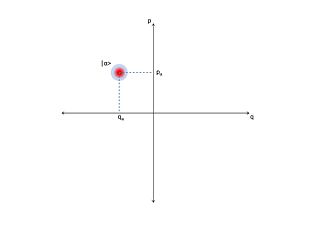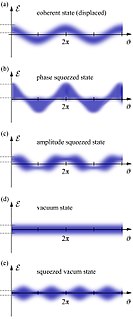Spontaneous emission is the process in which a quantum mechanical system transits from an excited energy state to a lower energy state and emits a quantized amount of energy in the form of a photon. Spontaneous emission is ultimately responsible for most of the light we see all around us; it is so ubiquitous that there are many names given to what is essentially the same process. If atoms are excited by some means other than heating, the spontaneous emission is called luminescence. For example, fireflies are luminescent. And there are different forms of luminescence depending on how excited atoms are produced. If the excitation is affected by the absorption of radiation the spontaneous emission is called fluorescence. Sometimes molecules have a metastable level and continue to fluoresce long after the exciting radiation is turned off; this is called phosphorescence. Figurines that glow in the dark are phosphorescent. Lasers start via spontaneous emission, then during continuous operation work by stimulated emission.
In physics, specifically in quantum mechanics, a coherent state is the specific quantum state of the quantum harmonic oscillator, often described as a state which has dynamics most closely resembling the oscillatory behavior of a classical harmonic oscillator. It was the first example of quantum dynamics when Erwin Schrödinger derived it in 1926, while searching for solutions of the Schrödinger equation that satisfy the correspondence principle. The quantum harmonic oscillator arise in the quantum theory of a wide range of physical systems. For instance, a coherent state describes the oscillating motion of a particle confined in a quadratic potential well. The coherent state describes a state in a system for which the ground-state wavepacket is displaced from the origin of the system. This state can be related to classical solutions by a particle oscillating with an amplitude equivalent to the displacement.
Quantum optics is a branch of atomic, molecular, and optical physics dealing with how individual quanta of light, known as photons, interact with atoms and molecules. It includes the study of the particle-like properties of photons. Photons have been used to test many of the counter-intuitive predictions of quantum mechanics, such as entanglement and teleportation, and are a useful resource for quantum information processing.

In physics, a squeezed coherent state is a quantum state that is usually described by two non-commuting observables having continuous spectra of eigenvalues. Examples are position and momentum of a particle, and the (dimension-less) electric field in the amplitude and in the mode of a light wave. The product of the standard deviations of two such operators obeys the uncertainty principle:
In physics, the Hanbury Brown and Twiss (HBT) effect is any of a variety of correlation and anti-correlation effects in the intensities received by two detectors from a beam of particles. HBT effects can generally be attributed to the wave–particle duality of the beam, and the results of a given experiment depend on whether the beam is composed of fermions or bosons. Devices which use the effect are commonly called intensity interferometers and were originally used in astronomy, although they are also heavily used in the field of quantum optics.
A quasiprobability distribution is a mathematical object similar to a probability distribution but which relaxes some of Kolmogorov's axioms of probability theory. Quasiprobabilities share several of general features with ordinary probabilities, such as, crucially, the ability to yield expectation values with respect to the weights of the distribution. They can however violate the σ-additivity axiom: integrating them over does not necessarily yield probabilities of mutually exclusive states. Indeed, quasiprobability distributions also counterintuitively have regions of negative probability density, contradicting the first axiom. Quasiprobability distributions arise naturally in the study of quantum mechanics when treated in phase space formulation, commonly used in quantum optics, time-frequency analysis, and elsewhere.
The Sudarshan-Glauber P representation is a suggested way of writing down the phase space distribution of a quantum system in the phase space formulation of quantum mechanics. The P representation is the quasiprobability distribution in which observables are expressed in normal order. In quantum optics, this representation, formally equivalent to several other representations, is sometimes championed over alternative representations to describe light in optical phase space, because typical optical observables, such as the particle number operator, are naturally expressed in normal order. It is named after George Sudarshan and Roy J. Glauber, who worked on the topic in 1963. Despite many useful applications in laser theory and coherence theory, the Glauber–Sudarshan P representation has the drawback that it is not always positive, and is not a true probability function.
Photon polarization is the quantum mechanical description of the classical polarized sinusoidal plane electromagnetic wave. An individual photon can be described as having right or left circular polarization, or a superposition of the two. Equivalently, a photon can be described as having horizontal or vertical linear polarization, or a superposition of the two.
The theoretical and experimental justification for the Schrödinger equation motivates the discovery of the Schrödinger equation, the equation that describes the dynamics of nonrelativistic particles. The motivation uses photons, which are relativistic particles with dynamics described by Maxwell's equations, as an analogue for all types of particles.
Resonance fluorescence is the process in which a two-level atom system interacts with the quantum electromagnetic field if the field is driven at a frequency near to the natural frequency of the atom.

The Husimi Q representation, introduced by Kôdi Husimi in 1940, is a quasiprobability distribution commonly used in quantum mechanics to represent the phase space distribution of a quantum state such as light in the phase space formulation. It is used in the field of quantum optics and particularly for tomographic purposes. It is also applied in the study of quantum effects in superconductors.
Photon antibunching generally refers to a light field with photons more equally spaced than a coherent laser field, a signature being signals at appropriate detectors which are anticorrelated. More specifically, it can refer to sub-Poissonian photon statistics, that is a photon number distribution for which the variance is less than the mean. A coherent state, as output by a laser far above threshold, has Poissonian statistics yielding random photon spacing; while a thermal light field has super-Poissonian statistics and yields bunched photon spacing. In the thermal (bunched) case, the number of fluctuations is larger than a coherent state; for an antibunched source they are smaller.

In quantum optics, an optical phase space is a phase space in which all quantum states of an optical system are described. Each point in the optical phase space corresponds to a unique state of an optical system. For any such system, a plot of the quadratures against each other, possibly as functions of time, is called a phase diagram. If the quadratures are functions of time then the optical phase diagram can show the evolution of a quantum optical system with time.
Linear optics is a sub-field of optics, consisting of linear systems, and is the opposite of nonlinear optics. Linear optics includes most applications of lenses, mirrors, waveplates, diffraction gratings, and many other common optical components and systems.
In quantum mechanics, the cat state, named after Schrödinger's cat, is a quantum state composed of two diametrically opposed conditions at the same time, such as the possibilities that a cat is alive and dead at the same time.
The Mandel Q parameter measures the departure of the occupation number distribution from Poissonian statistics. It was introduced in quantum optics by Leonard Mandel. It is a convenient way to characterize non-classical states with negative values indicating a sub-Poissonian statistics, which have no classical analog. It is defined as the normalized variance of the boson distribution:
Photon statistics is the theoretical and experimental study of the statistical distributions produced in photon counting experiments, which use Photodetectors to analyze the intrinsic statistical nature of photons in a light source. In these experiments, light incident on the photodetector generates photoelectrons and a counter registers electrical pulses generating a statistical distribution of photon counts. Low intensity disparate light sources can be differentiated by the corresponding statistical distributions produced in the detection process.
Coherence is defined as the ability of waves to interfere. Intuitively, coherent waves have a well-defined constant phase relationship. However, an exclusive and extensive physical definition of coherence is more nuanced. Coherence functions, as introduced by Roy Glauber and others in the 1960s, capture the mathematics behind the intuition by defining correlation between the electric field components as coherence. These correlations between electric field components can be measured to arbitrary orders, hence leading to the concept of different orders of coherence. The coherence encountered in most optical experiments, including the classic Young's double slit experiment and Mach-Zehnder interferometer, is first order coherence. Robert Hanbury Brown and Richard Q. Twiss performed a correlation experiment in 1956, and brought to light a different kind of correlation between fields, namely the correlation of intensities, which correspond to second order coherence. Higher order coherences become relevant in photon-coincidence counting experiments. Orders of coherence can be measured using classical correlation functions or by using the quantum analogue of those functions, which take quantum mechanical description of electric field (operators) as input. While the quantum coherence functions might yield the same results as the classical functions, the underlying mechanism and description of the physical processes are fundamentally different because quantum interference deals with interference of possible histories while classical interference deals with interference of physical waves.
The Dolinar Receiver is a device based upon the Kennedy receiver that may be used to discriminate between two or more low-amplitude coherent states of light using displacements and adaptive measurements. The ability to discriminate signals encoded in coherent light has applications in communications where losses are unavoidable, such as transmission along fiber optics cable, through the atmosphere, or across deep space.

In quantum physics, light is in a squeezed state if its electric field strength Ԑ for some phases has a quantum uncertainty smaller than that of a coherent state. The term squeezing thus refers to a reduced quantum uncertainty. To obey Heisenberg's uncertainty relation, a squeezed state must also have phases at which the electric field uncertainty is anti-squeezed, i.e. larger than that of a coherent state. Since 2019, the gravitational-wave observatories LIGO and Virgo employ squeezed laser light, which has significantly increased the rate of observed gravitational-wave events.






